Response from Horizon Regional Council
23 May 2023
Office of the Auditor General
P O Box 3928
WELLINGTON 6140
Attention: Hamish Duff, Performance Audit Lead
Tēnā koe Hamish
I refer to Leeanne McAviney’s letter of 5 April 2023 following up on performance audit on managing freshwater quality challenges and opportunities. I note that an extension for response was granted to 26 May 2023. Our response to recommendations 1, 2, 3 and 5 are provided as requested.
Recommendation 1.
The Ministry for the Environment and Statistics New Zealand lead work with regional councils and relevant land and freshwater management agencies to support better informed and coordinated management of freshwater by preparing a consistent approach to monitoring, analysis, and reporting of freshwater quality state and trend information.
Horizons Regional Council continues to engage and align with National Environmental Monitoring Standards (NEMS), including providing information, review and staff time to support the development of these standards; support the ongoing use and development of Land Air Water Aotearoa (LAWA) as a means of having national consistent reporting; and working to align with the requirements of the National Policy Statement for Freshwater Monitoring (NPS-FM) which will support further national consistency.
The benefits of these three key areas result in an overall more aligned approach nationally. The NEMS particularly addresses the sampling and processing methodologies. Reporting on LAWA includes the use of nationally developed trend assessment methodologies that Horizons RC use in all our trend reporting. Finally aligning with the NPS-FM will ensure the attributes (parameters) being monitored for are consistent and applied over the same time periods at the same frequencies etc. as the rest of the country.
We would support the Ministry for the Environment and Statistics New Zealand if they had an aspiration to provide leadership in these spaces, beyond that which is already occurring. This could include ongoing funding and support of the NEMS project, and those statistical State and Trend assessment models already nationally agreed upon through LAWA. Additionally, there are a range of areas where they could take a leadership role in addressing known concerns and issues. Two pertinent and readily available examples could include work to understand natural variability and long term weather pattern cycling and its implications for state and trend assessments; or guidance on undertaking the application of clause 3.19 and 3.20 of the NPS-FM. These aforementioned examples are situations where all regional councils are struggling as there is no currently understood nationally appropriate way to undertake this work, and certainly no nationally consistent approach. An envirolink fund grant led by Horizons Regional Council and supported by the regional sector is currently underway to attempt to address Natural Variability and Sampling Error and the issues these raise for derivation of state and trend assessments. This would be an example of an opportunity where the leadership and resources of MfE, and the statistical expertise of Statistics New Zealand could be leveraged to provide a piece of work that would be likely supported by all regional councils in the country (improving consistency) as there is currently no alternative, allowing access and consistency at the ground floor. Given these are requirements of the NPSFM that councils have to have implemented by the end of next calendar year, it would also represent a pressing need.
In our opinion there remains a leadership role for Ministry for the Environment and Statistics New Zealand to lead work with regional councils and relevant land and freshwater management agencies to support better informed and co-ordinated management of freshwater by preparing a consistent approach to monitoring, analysis, and reporting of freshwater quality state and trend information.
Recommendation 2.
Waikato Regional Council, Taranaki Regional Council, Horizons Regional Council, and Environment Southland consider how they might use the analysis conducted by National Institute of Water and Atmospheric Research Limited to improve their monitoring of freshwater quality.
The NIWA report identified a range of factors that go into the development of a monitoring network. In preparing a plan change under the NPS-FM, we have undertaken a range of additional analyses of our monitoring networks to ensure we are best able to address requirements of this legislation. As a result of this, we have more than doubled the number of Dissolved Oxygen continuous monitoring sites in our region; added in monthly deposited sediment at over 60 sites across the region; have engaged Cawthron to help us design and develop our monitoring networks in our lakes; and engaged Pattle Delamore Partners to advise us on groundwater monitoring and requirements under the NPS-FM.
Some of the key NIWA report recommendations included having more reference monitoring sites, and increasing monitoring sites of our network to better represent certain types of waterways (classes). Horizons has added one reference site (Oruakeretaki at Ruahine foothills) to better address some of these knowledge gaps, and continues to assess our network to ensure it is fit for purpose. In recent years, we have collaborated with neighbouring regions, to support each other’s networks. i.e. benefit can be drawn in representing certain river typologies/classes by combining networks. For example, Horizons relies upon a national set of sites for periphtyon concentration criteria derivation under the NPS-FM, and is working with Taranaki Regional Council to share data, to derive E. coli models.
While it is hard to attribute these activities directly to the specified NIWA report, HRC have continuing streams of work to address those areas for attention identified by said report.
Recommendation 3.
Waikato Regional Council, Taranaki Regional Council, Horizons Regional Council, and Environment Southland support and inform wider community discussion of freshwater quality issues by ensuring that the information they make available to their communities is clear, complete, up to date, consistent, accessible, and readily understandable.
Horizons science and research programme continues to improve our understanding of the region, helping make good decisions and target interventions more effectively. Sound communication of science is critical to informing stakeholders, advising decision-makers, empowering communities and plays a critical role in informing community conversations around the opportunities, and challenges, we face.
In recent years, efforts have been made to increase the visibility of – and access to – environmental data and information. This includes regular data feed into the Land, Air and Water Aotearoa (LAWA) website, and the informed development of non-regulatory programmes to address water quality issues such as the Manawatū River Leaders’ Accord, land management including our Sustainable Land Use Initiative (SLUI), biodiversity initiatives and biosecurity response.
In April 2022 Horizons launched a new website to host all content related to the Oranga Wai | Our Freshwater Future for the implementation of the National Policy Statement for Freshwater Management 2020 (NPS-FM). The website introduces the Oranga Wai programme, our approach to community engagement and the proposed Freshwater Management Units (FMUs). For each of the seven proposed FMUs a StoryMap introduces the river catchments and lakes within an FMU and the key pressures on freshwater. Data and information on the current state of water quality using the National Objective Framework (NOF) outlined in the NPS-FM and the current state of water allocation is displayed spatially. These StoryMaps are in place of FMU report cards published in previous years and are currently in the process of being updated with latest available results.
Horizons continues to work closely with independent science providers (Crown Research Institutes and science consultancies) to analyse and report on environmental data. At times data collected by Horizons is analysed and reported by external science providers (Crown Research Institutes and/or consultants) providing an independent standpoint. In other instances data analyses and reporting is completed by council officers and reviewed by external experts. Information on the review process for technical reports can be found inside the front cover. In late 2021 Council created a Science Communicator position to support in the communication of scientific knowledge to a general or non-technical audience. This role, facilitates the sharing of accurate, and meaningful data and information in accessible formats to support our partners, stakeholders, and communities in making decisions. An example of this work is the short video to support the technical report on State and Trends of Water Quality in the Manawatū Catchment. The video can be found here and the technical report here. Another example of this work is the short video to support the technical report on The Waiopehu FMU Water Quality Model. The video can be found here and the technical report here.
While we have always engaged with our community around our monitoring and research, the questions that are now being asked of the data and information we collect are becoming increasingly complex, as are the environmental and resource management challenges we face.
Communicating any gaps in our knowledge or understanding, and providing clarity around how this knowledge is applied to policy and/or decision making can also provide further understanding around the limitations of both science and policy. To this end, ensuring that we maintain the integrity of the data and information we collect is critical to building trust in our science and research.
Recommendation 5.
“Waikato Regional Council, Taranaki Regional Council, Horizons Regional Council, and Environment Southland use a full range of appropriate compliance, monitoring, and enforcement tools to effectively identify and act on material non-compliance with the Resource Management Act 1991 or resource consent conditions”.
Compliance Policy
Horizons has adopted a Compliance Monitoring Policy that provides high level guidance as to how Horizons will meet its compliance monitoring obligations, whilst at the same time acknowledging it has finite resources. This policy can be viewed here Compliance Monitoring Policy.
Note: This policy is in the process of being updated.
CME reporting
The number of consents monitored has generally increased over the last 5 years (see below figure). This is despite the fact that for both the 2020/21 and 2021/22 periods the compliance programmes were impacted by COVID-19 lockdowns and staff isolation requirements, which resulted in a decrease in the amount of actual consents monitored versus those planned to be monitored.
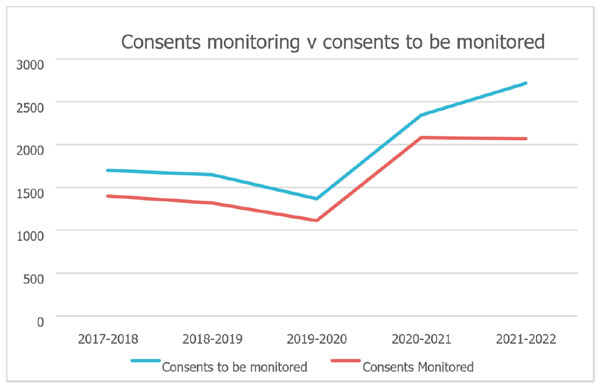
As shown in the figure below, over the period Horizons has utilised the full spread of compliance gradings as per the Ministry for the Environment Guidelines (note: Horizons has an additional Comply At Risk grading, which is used where the consent holder is compliant at the time of the inspection, but there have been matters identified that may result in future non-compliance. For reporting purposes these are included in the Comply-Full figures).
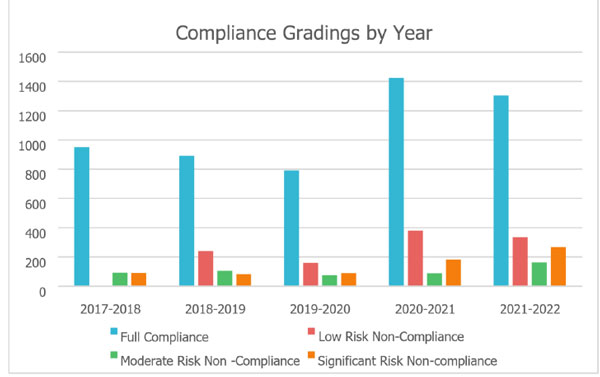
Incident Response
Horizons incident response programme is another important work stream where environmental non-compliance is identified. This programme predominately relies on members of the public phoning in to notify of potential and/or actual environmental incidents that may cause adverse effects on the environment.
Council responds to 100% of complaints, with a response including an inspection (immediate or planned), phone call or referred to another agency.
Whether a complaint requires a physical attendance is determined by the risk the incident poses to the environment based on the information Horizons has at the time of the complaint. Risk factors considered include, whether there is a discharge to the environment, the compliance history of the site/person in question, the nature or value of the receiving environment and the nature of the contaminant being discharged.
The below figure shows the number of complaints physically attended in relation to the total number of complaints received.
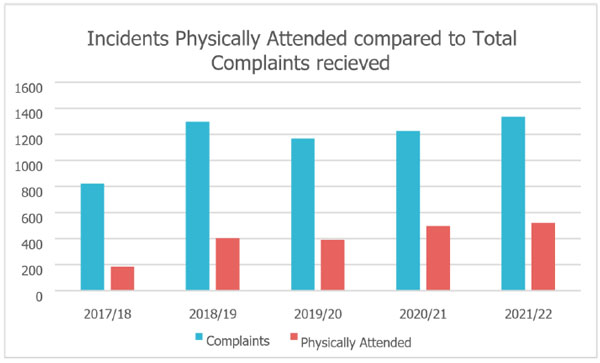
Formal enforcement action
As detailed below Horizons continues to use a wide spectrum of enforcement tools where appropriate. In relation to prosecutions it is important to note that one prosecution may result in multiple charges been filed.
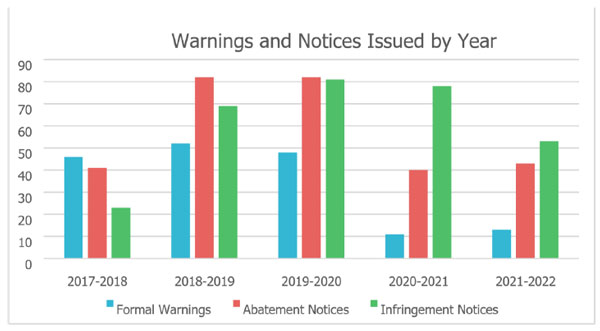
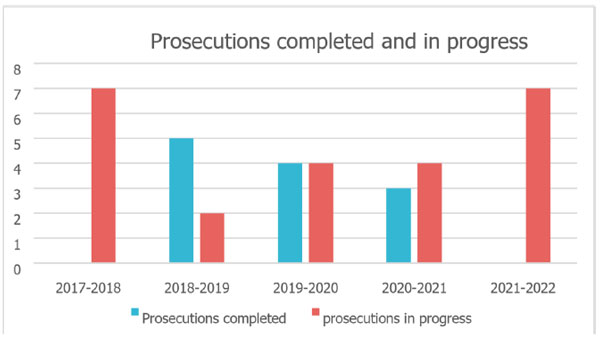
Over the period where prosecution cases have been completed the courts have delivered sentences. The total fines per year are detailed below, of which 90% is payable to Horizons. It is also important to note that prosecutions can span a number of financial years. Accordingly, whilst no fines may have been awarded for a year does not necessarily mean no prosecutions have been commenced for that year.

If you have any further follow-up please contact Charlotte Almond, Manager Policy and Strategy.
Nāku iti noa, nā
Nic Peet
Group Manager Strategy, Regulation and Science
